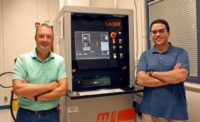TORONTO—Assembling a microrobot used to require a pair of needle-nosed tweezers, a microscope, steady hands, and at least eight hours. But now University of Toronto engineering researchers have developed a method that requires only a 3D printer and 20 minutes. Each magnetized microrobot is the size of a pin head and can travel through fluid-filled vessels and organs within the human body.
The microrobot is built by precisely arranging microscopic sections of magnetic needles atop a flat, flexible material. Once deployed, the researchers apply magnetic fields to induce microrobots to travel with worm-like motion through fluid channels or close its tiny mechanical jaws to take a tissue sample.
The researchers have developed an automated assembly approach that significantly cuts down on design and development time, expanding the types of microrobots they can manufacture. Smaller and more complex microrobots are needed for future medical applications, such as targeted drug delivery, assisted fertilization, or biopsies.
Thus far, researchers have devised more than 20 different robotic shapes, which have been programmed into a 3D printer. The printer then builds and solidifies the design, orienting the magnetically patterned particles as part of the process.
Using 3D printing not only enables researchers to easily iterate, design and refine the microrobots. It also allows them to develop even smaller and more complex microrobots than the current millimeter-size. One researcher is hopeful this approach will allow them to make a microrobot up to to times smaller.
Researchers use Magnetic 3D Printing to Make Microrobots

Looking for a reprint of this article?
From high-res PDFs to custom plaques, order your copy today!





